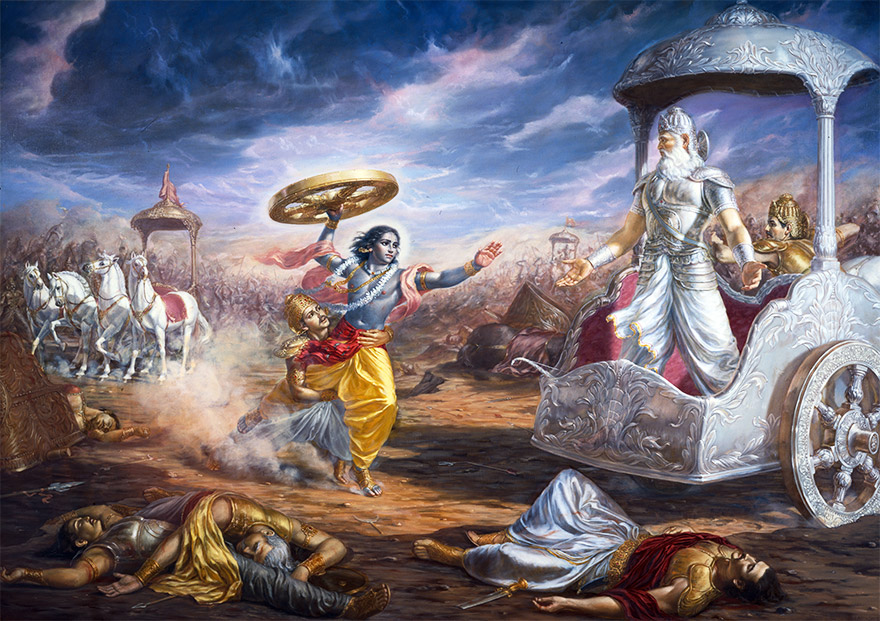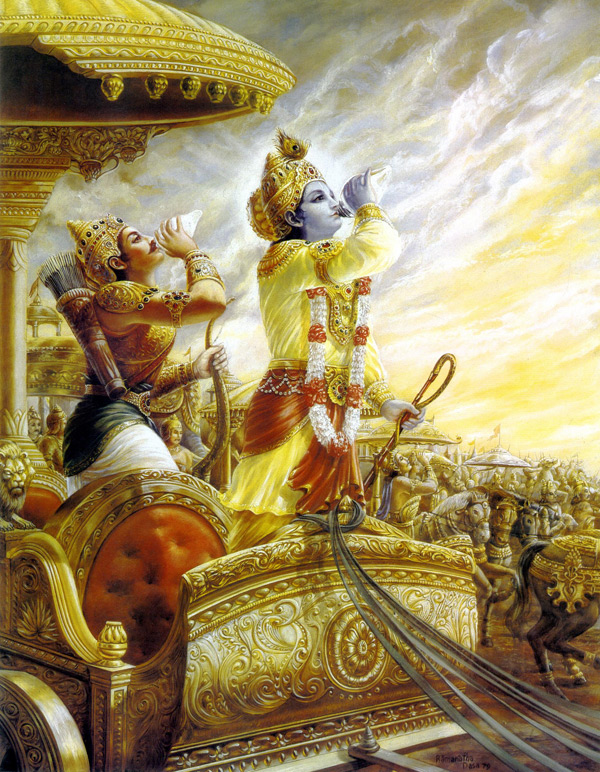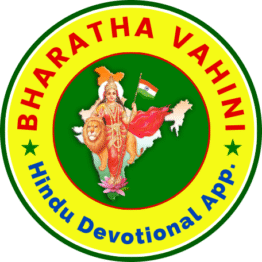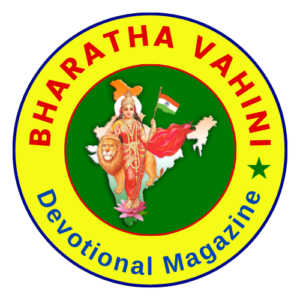BHAGAVAD GITA CHAPTER 1 – ARJUNA VISHADA YOGA
SHLOKA – 01
धृतराष्ट्र उवाच
धर्मक्षेत्रे कुरुक्षेत्रे समवेता युयुत्सवः।
मामकाः पाण्डवाश्चैव किमकुर्वत सञ्जय॥१॥
TRANSLATION
Dhritarashtra said: “O Sanjaya, what did my sons and the sons of Pandu do, gathered on the sacred field of Kurukshetra, eager to fight?”
EXPLANATION
Dhritarashtra, the blind king and father of the Kauravas, asks Sanjaya, his charioteer with divine vision, to describe the events at Kurukshetra, called a “field of righteousness.” His question shows curiosity mixed with worry about the war between his sons (Kauravas) and the Pandavas. By calling them “my sons” and “sons of Pandu,” he reveals his bias toward his own children. His blindness symbolizes ignorance, a theme that will unfold as the Gita explores the battle between right and wrong.
SHLOKA – 02
सञ्जय उवाच
दृष्ट्वा तु पाण्डवानीकं व्यूढं दुर्योधनस्तदा।
आचार्यमुपसङ्गम्य राजा वचनमब्रवीत्॥२॥
TRANSLATION
Sanjaya said: “Seeing the Pandava army arranged in formation, King Duryodhana then approached his teacher Drona and spoke these words.”
EXPLANATION
Sanjaya begins narrating. Duryodhana, the Kaurava prince, sees the Pandavas’ well-organized army and feels uneasy. He goes to Drona, his teacher and a skilled warrior, to share his thoughts. The Pandavas’ formation shows their preparation, while Duryodhana’s approach to Drona highlights his reliance on his mentor and hints at his growing concern about the battle ahead.
SHLOKA – 03
पश्यैतां पाण्डुपुत्राणामाचार्य महतीं चमूम्।
व्यूढां द्रुपदपुत्रेण तव शिष्येण धीमता॥३॥
TRANSLATION
“Behold, O Teacher, this great army of the sons of Pandu, expertly arranged by your intelligent disciple, the son of Drupada.”
EXPLANATION
Duryodhana points out the Pandava army to Drona, praising its size and arrangement. He notes it is led by Dhrishtadyumna, Drona’s own student and son of Drupada, a rival king. This remark shows Duryodhana’s worry about facing a capable leader trained by Drona, subtly questioning his teacher’s role in strengthening the enemy.
![100+] Bhagavad Gita Wallpapers | Wallpapers.com](https://wallpapers.com/images/hd/bhagavad-gita-hindu-deities-vgehwgxltln9cops.jpg)
SHLOKA – 04
अत्र शूरा महेष्वासा भीमार्जुनसमा युधि।
युयुधानो विराटश्च द्रुपदश्च महारथः॥४॥
TRANSLATION
“Here are heroes, mighty archers equal to Bhima and Arjuna in battle—Yuyudhana, Virata, and the great warrior Drupada.”
EXPLANATION
Duryodhana lists powerful warriors on the Pandava side, comparing them to Bhima and Arjuna, the strongest Pandavas. Yuyudhana (Satyaki), King Virata, and Drupada are skilled fighters. Naming them shows Duryodhana’s fear of their strength and his attempt to assess the challenge his army faces.
SHLOKA – 05
धृष्टकेतुश्चेकितानः काशिराजश्च वीर्यवान्।
पुरुजित्कुन्तिभोजश्च शैब्यश्च नरपुङ्गवः॥५॥
TRANSLATION
“Dhrishtaketu, Chekitana, the valiant king of Kashi, Purujit, Kuntibhoja, and Shaibya—the best of men.”
EXPLANATION
Duryodhana continues naming more brave Pandava allies: Dhrishtaketu, Chekitana, the Kashi king, Purujit, Kuntibhoja, and Shaibya. These are respected leaders and warriors. Mentioning them reflects his growing realization of the formidable opposition, adding to his unease.
SHLOKA – 06
युधामन्युश्च विक्रान्त उतमौजाश्च वीर्यवान्।
सौभद्रो द्रौपदेयाश्च सर्व एव महारथाः॥६॥
TRANSLATION
“The courageous Yudhamanyu, the mighty Uttamaujas, the son of Subhadra, and the sons of Draupadi—all great chariot warriors.”
EXPLANATION
Duryodhana names additional Pandava heroes: Yudhamanyu, Uttamaujas, Abhimanyu (son of Arjuna and Subhadra), and Draupadi’s sons. Calling them “great chariot warriors” emphasizes their combat skills. This further highlights the strength he must confront, fueling his anxiety.
SHLOKA – 07
अस्माकं तु विशिष्टा ये तान्निबोध द्विजोत्तम।
नायका मम सैन्यस्य संज्ञार्थं तान्ब्रवीमि ते॥७॥
TRANSLATION
“But know, O best of Brahmins, the distinguished leaders of my army. I will name them for your understanding.”
EXPLANATION
Duryodhana now shifts to his own army, addressing Drona as “best of Brahmins” to show respect. He prepares to list his key warriors, possibly to boost his own morale or convince Drona of their strength after focusing on the Pandavas’ might. This transition reveals his need to reassure himself.

SHLOKA – 08
भवान्भीष्मश्च कर्णश्च कृपश्च समितिञ्जयः।
अश्वत्थामा विकर्णश्च सौमदत्तिस्तथैव च॥८॥
TRANSLATION
“Yourself, Bhishma, Karna, and Kripa, victorious in battle; Ashwatthama, Vikarna, and the son of Somadatta too.”
EXPLANATION
Duryodhana names his top warriors: Drona, Bhishma (the grandsire), Karna (a master archer), Kripa (a teacher), Ashwatthama (Drona’s son), Vikarna (his brother), and Saumadatti (Bhurishravas). These are renowned fighters. Listing them is his attempt to counter his fears about the Pandavas with confidence in his own side.
SHLOKA – 09
अन्ये च बहवः शूरा मदर्थे त्यक्तजीविताः।
नानाशस्त्रप्रहरणाः सर्वे युद्धविशारदाः॥९॥
TRANSLATION
“And many other heroes, ready to give their lives for me, armed with various weapons, all skilled in warfare.”
EXPLANATION
Duryodhana adds that he has numerous other brave soldiers willing to die for him. They carry diverse weapons and are battle experts. This broad statement aims to emphasize the size and dedication of his forces, though it also hints at his reliance on numbers to feel secure.
SHLOKA – 10
अपर्याप्तं तदस्माकं बलं भीष्माभिरक्षितम्।
पर्याप्तं त्विदमेतेषां बलं भीमाभिरक्षितम्॥१०॥
TRANSLATION
“Our strength, protected by Bhishma, is insufficient, while their strength, protected by Bhima, is sufficient.”
EXPLANATION
Duryodhana compares the armies, admitting that his side, led by Bhishma, seems weak, while the Pandavas, guarded by Bhima, appear strong. This surprising confession reveals his doubt and insecurity, despite his earlier boasting. It shows the conflict within him as the war approaches.
SHLOKA – 11
अयनेषु च सर्वेषु यथाभागमवस्थिताः।
भीष्ममेवाभिरक्षन्तु भवन्तः सर्व एव हि॥११॥
TRANSLATION
“All of you, stationed in your respective positions, must surely protect Bhishma above all.”
EXPLANATION
Duryodhana instructs his warriors to stay in their assigned places and prioritize protecting Bhishma, the grandsire and commander of the Kaurava army. This shows Bhishma’s importance as a skilled and respected leader. Duryodhana’s focus on Bhishma reveals his dependence on him to win the war, despite his earlier doubts about their strength.

SHLOKA – 12
तस्य सञ्जनयन्हर्षं कुरुवृद्धः पितामहः।
सिंहनादं विनद्योच्चैः शङ्खं दध्मौ प्रतापवान्॥१२॥
TRANSLATION
“To cheer him up, the valiant elder of the Kurus, the grandsire Bhishma, roared like a lion and loudly blew his conch.”
EXPLANATION
Bhishma, the eldest of the Kuru dynasty, responds to Duryodhana’s words by blowing his conch with a lion-like roar. This act is meant to boost Duryodhana’s morale and signal the start of battle. Bhishma’s energy and leadership shine through, showing his commitment to the Kauravas despite his inner conflict about fighting the Pandavas.
SHLOKA – 13
ततः शङ्खाश्च भेर्यश्च पणवानकगोमुखाः।
सहसैवाभ्यहन्यन्त स शब्दस्तुमुलोऽभवत्॥१३॥
TRANSLATION
“Then, conches, drums, trumpets, and horns suddenly sounded together, and the noise was tremendous.”
EXPLANATION
Following Bhishma’s lead, the Kaurava army’s instruments—conches, drums, trumpets, and horns—blare all at once. The loud, chaotic sound fills the battlefield, marking the war’s beginning. This noise reflects the intensity and tension of the moment, setting a dramatic tone for the conflict ahead.
SHLOKA – 14
ततः श्वेतैर्हयैर्युक्ते महति स्यन्दने स्थितौ।
माधवः पाण्डवश्चैव दिव्यौ शङ्खौ प्रदध्मतुः॥१४॥
TRANSLATION
“Then, stationed in a grand chariot drawn by white horses, Madhava (Krishna) and the Pandava (Arjuna) blew their divine conches.”
EXPLANATION
On the Pandava side, Krishna (called Madhava) and Arjuna, standing in a splendid chariot with white horses, blow their sacred conches. The white horses and divine conches symbolize purity and strength. This moment introduces Krishna’s active role and Arjuna’s prominence, contrasting with the Kauravas’ noisy display.
SHLOKA – 15
पाञ्चजन्यं हृषीकेशो देवदत्तं धनञ्जयः।
पौण्ड्रं दध्मौ महाशङ्खं भीमकर्मा वृकोदरः॥१५॥
TRANSLATION
“Hrishikesha (Krishna) blew Panchajanya, Dhananjaya (Arjuna) blew Devadatta, and Bhima, the doer of mighty deeds, blew his great conch Paundra.”
EXPLANATION
Krishna blows his conch Panchajanya, Arjuna blows Devadatta, and Bhima, known for his strength (Vrikodara, “wolf-bellied”), blows Paundra. Each conch has a unique name and divine origin, showing the Pandavas’ power and readiness. Bhima’s title “doer of mighty deeds” emphasizes his fearsome reputation, which Duryodhana fears.
SHLOKA – 16
अनन्तविजयं राजा कुन्तीपुत्रो युधिष्ठिरः।
नकुलः सहदेवश्च सुघोषमणिपुष्पकौ॥१६॥
TRANSLATION
“King Yudhishthira, the son of Kunti, blew Anantavijaya; Nakula and Sahadeva blew Sughosha and Manipushpaka.”
EXPLANATION
Yudhishthira, the eldest Pandava and a king, blows Anantavijaya (“endless victory”), while his brothers Nakula and Sahadeva blow Sughosha (“sweet-sounding”) and Manipushpaka (“jewel flower”). Their conches add to the Pandavas’ united front, showing their determination and harmony as they prepare for battle.
SHLOKA – 17
काश्यश्च परमेष्वासः शिखण्डी च महारथः।
धृष्टद्युम्नो विराटश्च सात्यकिश्चापराजितः॥१७॥
TRANSLATION
“The king of Kashi, a supreme archer, Shikhandi the great warrior, Dhrishtadyumna, Virata, and the invincible Satyaki.”
EXPLANATION
This shloka lists more Pandava warriors who join in: the Kashi king (a master archer), Shikhandi (destined to cause Bhishma’s fall), Dhrishtadyumna (Drona’s foe), Virata (a king), and Satyaki (Yuyudhana, unbeatable). Their participation strengthens the Pandava side, showing their diverse and powerful allies.
![🔥 [80+] Gita Wallpapers | WallpaperSafari](https://cdn.wallpapersafari.com/43/25/lr6KQ4.jpg)
SHLOKA – 18
द्रुपदो द्रौपदेयाश्च सर्वशः पृथिवीपते।
सौभद्रश्च महाबाहुः शङ्खान्दध्मुः पृथक्पृथक्॥१८॥
TRANSLATION
“Drupada, the sons of Draupadi, and the mighty-armed son of Subhadra, O lord of the earth, blew their conches separately.”
EXPLANATION
Drupada (king and father of Dhrishtadyumna), Draupadi’s five sons, and Abhimanyu (son of Arjuna and Subhadra, called “mighty-armed”) blow their conches individually. Addressing Sanjaya as “lord of the earth” shows respect. The separate sounds highlight the Pandavas’ large, united force, adding to the battlefield’s intensity.
SHLOKA – 19
स घोषो धार्तराष्ट्राणां हृदयानि व्यदारयत्।
नभश्च पृथिवीं चैव तुमुलो व्यनुनादति॥१९॥
TRANSLATION
“That sound pierced the hearts of Dhritarashtra’s sons, resounding through the sky and earth with a tremendous roar.”
EXPLANATION
The Pandavas’ conch sounds overwhelm the Kauravas, striking fear into their hearts. The noise echoes across the sky and earth, showing the Pandavas’ morale and power. This moment shifts the mood, as the Kauravas, especially Duryodhana, feel the weight of their opponents’ confidence.
SHLOKA – 20
अथ व्यवस्थितान्दृष्ट्वा धार्तराष्ट्रान् कपिध्वजः।
प्रवृत्ते शस्त्रसम्पाते धनुरुद्यम्य पाण्डवः॥२०॥
TRANSLATION
“Then, seeing the sons of Dhritarashtra arrayed, the Pandava with the monkey banner, as weapons were about to clash, raised his bow.”
EXPLANATION
Arjuna, called “Kapidhvaja” (with a monkey banner, linked to Hanuman), sees the Kaurava army ready for battle. As the moment of combat nears, he lifts his bow, signaling his readiness. This marks a turning point, leading to his inner conflict in the next shlokas, which sets the stage for Krishna’s teachings.
SHLOKA – 21
अर्जुन उवाच
सेनयोरुभयोर्मध्ये रथं स्थापय मेऽच्युत।
यावदेतान्निरीक्षेऽहं योद्धुकामानवस्थितान्॥२१॥
TRANSLATION
Arjuna said: “O Achyuta (Krishna), place my chariot between the two armies so I can see those who stand here eager to fight.”
EXPLANATION
Arjuna speaks to Krishna, calling him “Achyuta” (the infallible one), showing his trust. He asks Krishna, his charioteer, to position their chariot between the Pandava and Kaurava armies. He wants to observe the warriors ready for battle, indicating his initial curiosity and intent to assess the situation before fighting begins.
SHLOKA – 22
कैरहं संनादति योद्धव्यमस्मिन् रणसमुद्यमे।
यावदेतान्निरीक्षेऽहं योद्धुकामानवस्थितान्॥२२॥
TRANSLATION
“With whom must I fight in this outbreak of war? Let me see those who are here, eager for battle.”
EXPLANATION
Arjuna continues, wondering who he must face in the war. He repeats his request to see the warriors, showing his desire to understand the enemy. This reflects his role as a warrior preparing for action, but it also hints at the emotional struggle that will soon emerge as he recognizes familiar faces.
![100+] Bhagavad Gita Wallpapers | Wallpapers.com](https://wallpapers.com/images/hd/bhagavad-gita-hindu-deities-vgehwgxltln9cops.jpg)
SHLOKA – 23
योत्स्यमानानवेक्षेऽहं य एतेऽत्र समागताः।
धार्तराष्ट्रस्य दुर्बुद्धेर्युद्धे प्रियचिकीर्षवः॥२३॥
TRANSLATION
“Let me look at those gathered here to fight, who have come to please the evil-minded son of Dhritarashtra in this war.”
EXPLANATION
Arjuna wants to see the warriors assembled to support Duryodhana, whom he calls “evil-minded” (durbuddhi). He notes that they are here to please Duryodhana, suggesting their loyalty is misplaced. This shows Arjuna’s initial judgment of the Kauravas, setting the stage for his later moral dilemma.
SHLOKA – 24
सञ्जय उवाच
एवमुक्तो हृषीकेशो गुडाकेशेन भारत।
सेनयोरुभयोर्मध्ये स्थापयित्वा रथोत्तमम्॥२४॥
TRANSLATION
Sanjaya said: “Thus addressed by Gudakesha (Arjuna), Hrishikesha (Krishna), O Bharata, placed the splendid chariot between the two armies.”
EXPLANATION
Sanjaya narrates to Dhritarashtra (called “Bharata”). Arjuna, nicknamed “Gudakesha” (conqueror of sleep), asks Krishna, “Hrishikesha” (lord of the senses), to act. Krishna drives their magnificent chariot to the middle of the battlefield, fulfilling Arjuna’s request and showing his role as both guide and friend.
SHLOKA – 25
भीष्मद्रोणप्रमुखतः सर्वेषां च महीक्षिताम्।
उवाच पार्थ पश्यैतान् समवेतान् कुरूनिति॥२५॥
TRANSLATION
“Facing Bhishma, Drona, and all the kings, he said, ‘O Partha (Arjuna), behold these assembled Kurus.'”
EXPLANATION
Krishna positions the chariot in front of Bhishma, Drona, and the gathered kings. He calls Arjuna “Partha” (son of Pritha/Kunti) and invites him to look at the Kurus—both Pandavas and Kauravas, as they are all part of the Kuru dynasty. This moment prepares Arjuna to see his own relatives, sparking his inner conflict.
SHLOKA – 26
तत्रापश्यत्स्थितान्पार्थः पितॄनथ पितामहान्।
आचार्यान्मातुलान्भ्रातॄन्पुत्रान्पौत्रान्सखींस्तथा॥२६॥
TRANSLATION
“There, Partha saw fathers, grandfathers, teachers, uncles, brothers, sons, grandsons, and friends standing.”
EXPLANATION
Arjuna (Partha) looks and sees familiar faces on both sides: fathers, grandfathers like Bhishma, teachers like Drona, uncles, brothers, sons, grandsons, and friends. This sight overwhelms him, as the war pits family against family, laying the foundation for his emotional turmoil.
SHLOKA – 27
श्वशुरान्सुहृदश्चैव सेनयोरुभयोरपि।
तान्समीक्ष्य स कौन्तेयः सर्वान्बन्धूनवस्थितान्॥२७॥
TRANSLATION
“Fathers-in-law and dear friends too, in both armies. Seeing all these relatives present, the son of Kunti (Arjuna)…”
EXPLANATION
Arjuna notices fathers-in-law and close friends in both the Pandava and Kaurava armies. As Kunti’s son, he feels a deep connection to these “bandhus” (relatives). Seeing them ready to fight each other fills him with distress, marking the start of his moral and emotional crisis.
SHLOKA – 28
कृपया परयाविष्टो विषीदन्निदमब्रवीत्।
दृष्ट्वेमं स्वजनं कृष्ण युयुत्सुं समुपस्थितम्॥२८॥
TRANSLATION
“Overcome with deep compassion, grieving, he spoke: ‘Seeing my own people, Krishna, standing here eager to fight…'”
EXPLANATION
Arjuna, struck by compassion and sorrow, begins to break down. He addresses Krishna directly, sharing his pain at seeing his own kin—family and friends—ready to battle. His grief signals the shift from a warrior’s mindset to one of doubt and sadness, setting up the Gita’s core teachings.

SHLOKA – 29
सीदन्ति मम गात्राणि मुखं च परिशुष्यति।
वेपथुश्च शरीरे मे रोमहर्षश्च जायते॥२९॥
TRANSLATION
“‘My limbs fail, my mouth dries up, my body trembles, and my hair stands on end.'”
EXPLANATION
Arjuna describes his physical reaction to the situation. His body weakens, his mouth goes dry, he shakes, and his hair bristles with fear and anguish. These signs show his overwhelming emotional response to facing his loved ones in war, revealing his inner turmoil.
SHLOKA – 30
गाण्डीवं स्रंसते हस्तात्त्वक्चैव परिदह्यते।
न च शक्नोम्यवस्थातुं भ्रमतीव च मे मनः॥३०॥
TRANSLATION
“‘Gandiva slips from my hand, my skin burns, I cannot stand steady, and my mind seems to whirl.'”
EXPLANATION
Arjuna’s famous bow, Gandiva, falls from his grip, his skin feels like it’s burning, he struggles to stand, and his mind spins in confusion. This vivid description captures his complete breakdown—physical, mental, and emotional—as the reality of fighting his own people sinks in.
SHLOKA – 31
निमित्तानि च पश्यामि विपरीतानि केशव।
न च श्रेयोऽनुपश्यामि हत्वा स्वजनमाहवे॥३१॥
TRANSLATION
“I see only bad omens, O Keshava (Krishna), and I see no good in killing my own people in this battle.”
EXPLANATION
Arjuna, calling Krishna “Keshava” (one with beautiful hair), shares his despair. He sees signs of misfortune and believes no good will come from killing his relatives. This reflects his growing fear and moral confusion about the war’s purpose and consequences.
SHLOKA – 32
न काङ्क्षे विजयं कृष्ण न च राज्यं सुखानि च।
किं नो राज्येन गोविन्द किं भोगैर्जीवितेन वा॥३२॥
TRANSLATION
“I do not desire victory, Krishna, nor kingdom, nor pleasures. What use is a kingdom to us, O Govinda, or enjoyments, or even life?”
EXPLANATION
Arjuna tells Krishna, also called “Govinda” (cowherd), that he no longer wants victory, a kingdom, or happiness. He questions the value of these things if they come at the cost of his loved ones’ lives, showing his disillusionment with the war’s rewards.
SHLOKA – 33
येषामर्थे काङ्क्षितं नो राज्यं भोगाः सुखानि च।
त इमेऽवस्थिता युद्धे प्राणांस्त्यक्त्वा धनानि च॥३३॥
TRANSLATION
“Those for whose sake we desire kingdom, enjoyments, and happiness stand here in battle, giving up their lives and wealth.”
EXPLANATION
Arjuna points out the irony: the very people he wants to win a kingdom and happiness for—his family—are now risking their lives and riches in this war. This contradiction deepens his sorrow and sense of futility about fighting.
SHLOKA – 34
आचार्याः पितरः पुत्रास्तथा चैव पितामहाः।
मातुलाः श्वशुराः पौत्राः श्यालाः सम्बन्धिनस्तथा॥३४॥
TRANSLATION
“Teachers, fathers, sons, grandfathers, uncles, fathers-in-law, grandsons, brothers-in-law, and other relatives too.”
EXPLANATION
Arjuna lists the relationships he sees on the battlefield: teachers like Drona, fathers, sons, grandfathers like Bhishma, and various kin. Naming them emphasizes the personal stakes for him, making the idea of killing them unbearable.

SHLOKA – 35
एतान्न हन्तुमिच्छामि घ्नतोऽपि मधुसूदन।
अपि त्रैलोक्यराज्यस्य हेतोः किं नु महीकृते॥३५॥
TRANSLATION
“I do not wish to kill them, O Madhusudana (Krishna), even if they kill me—not even for the rule of the three worlds, let alone this earth.”
EXPLANATION
Arjuna calls Krishna “Madhusudana” (slayer of the demon Madhu) and says he refuses to kill his kin, even if they attack him. He wouldn’t fight for the three worlds (heaven, earth, and underworld), much less just the earth, showing how deeply he values family over power.
SHLOKA – 36
निहत्य धार्तराष्ट्रान्नः का प्रीतिः स्याज्जनार्दन।
पापमेवाश्रयेदस्मान्हत्वैतानाततायिनः॥३६॥
TRANSLATION
“What joy would we find in killing Dhritarashtra’s sons, O Janardana (Krishna)? Sin would surely come to us by slaying these aggressors.”
EXPLANATION
Arjuna, addressing Krishna as “Janardana” (protector of people), questions the happiness in killing the Kauravas. He believes that even though they are attackers, killing them would bring sin, revealing his fear of moral consequences over victory.
SHLOKA – 37
तस्मान्नार्हा वयं हन्तुं धार्तराष्ट्रान्स्वबान्धवान्।
स्वजनं हि कथं हत्वा सुखिनः स्याम माधव॥३७॥
TRANSLATION
“Therefore, we should not kill Dhritarashtra’s sons, our own relatives. How can we be happy after killing our own people, O Madhava (Krishna)?”
EXPLANATION
Arjuna, calling Krishna “Madhava” (descendant of Madhu), argues that they shouldn’t harm their Kaurava relatives. He wonders how happiness could follow such an act, showing his belief that the emotional cost outweighs any gain from the war.
SHLOKA – 38
यद्यप्येते न पश्यन्ति लोभोपहतचेतसः।
कुलक्षयकृतं दोषं मित्रद्रोहे च पातकम्॥३८॥
TRANSLATION
“Even if they, with minds clouded by greed, do not see the fault in destroying the family or the sin of betraying friends…”
EXPLANATION
Arjuna says the Kauravas, blinded by greed, fail to recognize the wrong in ruining their family or betraying allies. He contrasts their ignorance with his awareness, suggesting he feels a higher moral responsibility to avoid this destruction.
SHLOKA – 39
कथं न ज्ञेयमस्माभिः पापादस्मान्निवर्तितुम्।
कुलक्षयकृतं दोषं प्रपश्यद्भिर्जनार्दन॥३९॥
TRANSLATION
“Why should we not know to turn away from this sin, O Janardana (Krishna), when we see the fault in destroying the family?”
EXPLANATION
Arjuna asks Krishna why they shouldn’t avoid this sin, since they understand the harm of family destruction. Calling Krishna “Janardana” again, he seeks guidance, showing his struggle between duty as a warrior and his ethical concerns.
SHLOKA – 40
कुलक्षये प्रणश्यन्ति कुलधर्माः सनातनाः।
धर्मे नष्टे कुलं कृत्स्नमधर्मोऽभिभवत्युत॥४०॥
TRANSLATION
“When a family is destroyed, its ancient traditions perish. When dharma is lost, adharma overcomes the entire family.”
EXPLANATION
Arjuna explains that killing the family would end its timeless traditions (dharma). Without dharma (righteousness), adharma (unrighteousness) would take over, affecting everyone. He fears the war’s broader impact on society and morality.
![🔥 [80+] Gita Wallpapers | WallpaperSafari](https://cdn.wallpapersafari.com/43/25/lr6KQ4.jpg)
SHLOKA – 41
अधर्माभिभवात्कृष्ण प्रदुष्यन्ति कुलस्त्रियः।
स्त्रीषु दुष्टासु वार्ष्णेय जायते वर्णसङ्करः॥४१॥
TRANSLATION
“When adharma prevails, O Krishna, the women of the family become corrupted. When women are corrupted, O Varshneya, caste confusion arises.”
EXPLANATION
Arjuna tells Krishna, also called “Varshneya” (of the Vrishni clan), that unrighteousness corrupts family women. This leads to “varna-sankara” (mixing of castes), disrupting social order. He worries about the war’s long-term consequences on lineage and society.
SHLOKA – 42
सङ्करो नरकायैव कुलघ्नानां कुलस्य च।
पतन्ति पितरो ह्येषां लुप्तपिण्डोदकक्रियाः॥४२॥
TRANSLATION
“This confusion leads to hell for both the family and its destroyers. Their ancestors fall, deprived of offerings of food and water.”
EXPLANATION
Arjuna says this caste mixing dooms the family and its killers to hell. Without descendants to perform rituals (offerings of food and water), ancestors suffer. He fears the spiritual ruin of his lineage, adding to his reluctance.
SHLOKA – 43
दोषैरेतैः कुलघ्नानां वर्णसङ्करकारकैः।
उत्साद्यन्ते जातिधर्माः कुलधर्माश्च शाश्वताः॥४३॥
TRANSLATION
“By these faults of the family destroyers, which cause caste confusion, the eternal duties of caste and family are wiped out.”
EXPLANATION
Arjuna believes the sins of killing kin and mixing castes destroy the everlasting duties of both caste and family. He sees this as a collapse of sacred traditions, amplifying his argument against fighting.
SHLOKA – 44
उत्सन्नकुलधर्माणां मनुष्याणां जनार्दन।
नरके नियतं वासो भवतीत्यनुशुश्रुम॥४४॥
TRANSLATION
“We have heard, O Janardana (Krishna), that those whose family duties are destroyed must dwell in hell for a long time.”
EXPLANATION
Arjuna, addressing Krishna as “Janardana,” recalls a teaching: those who lose family traditions face prolonged suffering in hell. This traditional belief strengthens his fear of the war’s spiritual consequences.
![100+] Bhagavad Gita Wallpapers | Wallpapers.com](https://wallpapers.com/images/hd/bhagavad-gita-hindu-deities-vgehwgxltln9cops.jpg)
SHLOKA – 45
अहो बत महत्पापं कर्तुं व्यवसिता वयम्।
यद्राज्यसुखलोभेन हन्तुं स्वजनमुद्यताः॥४५॥
TRANSLATION
“Alas, what a great sin we are about to commit, driven by greed for kingdom and happiness, ready to kill our own people.”
EXPLANATION
Arjuna laments (“Alas!”) the grave sin he and his brothers are prepared to commit for the sake of a kingdom and pleasure. His regret highlights his inner conflict between royal ambition and moral duty.
SHLOKA – 46
यदि मामप्रतीकारमशस्त्रं शस्त्रपाणयः।
धार्तराष्ट्रा रणे हन्युस्तन्मे क्षेमतरं भवेत्॥४६॥
TRANSLATION
“If the armed sons of Dhritarashtra kill me in battle, unarmed and unresisting, that would be better for me.”
EXPLANATION
Arjuna says he’d rather let the Kauravas kill him—defenseless and not fighting back—than kill them. This extreme stance shows his complete rejection of the war, preferring death over harming his kin.
SHLOKA – 47
सञ्जय उवाच
एवमुक्त्वार्जुनः सङ्ख्ये रथोपस्थ उपाविशत्।
विसृज्य सशरं चापं शोकसंविग्नमानसः॥४७॥
TRANSLATION
Sanjaya said: “Having spoken thus, Arjuna, in the midst of the battle, sat down on his chariot, dropping his bow and arrows, his mind overwhelmed with grief.”
EXPLANATION
Sanjaya narrates Arjuna’s collapse. After pouring out his heart, Arjuna sits in his chariot, letting go of his bow and arrows. Overcome by sorrow, he can no longer fight, marking the peak of his despair and the end of Chapter 1.

Dear Hindu relatives…
Like this, entire “BHAGAVAD GITA – 18 Chapters” are here along with explanations.
If you take any Subscription Plan… you will receive the premium version of Bhaaratha Vahini.
This premium version grants you unlimited access to all contents in this App, including our “BHAARATHA VAHINI” Monthly Magazine (E-Paper).


